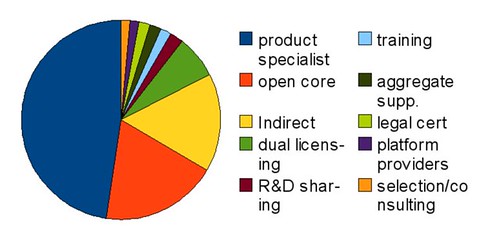After the publication of our revised OSS business model taxonomy, we have finally finished the second survey from FLOSSMETRICS, that now covers 218 companies (again, excluding companies that have less than 30% of revenues coming from OSS, and excluding companies that sell a proprietary product based on OSS, as there are simply too many of them). Some companies are using more than one model (for example, many dual-licensing companies also sell services and support, and thus can be classified also as product specialists).
With the actual numbers:
| Model name | # companies |
| product specialist | 131 |
| open core | 52 |
| Indirect | 44 |
| dual licensing | 19 |
| R&D sharing | 6 |
| training | 5 |
| aggregate supp. | 5 |
| legal cert | 5 |
| platform providers | 4 |
| selection/consulting | 4 |
Some important considerations: product specialists are counted only when there is a demonstrable participation of the company into the project as “main committer”; otherwise, the number of specialists would be much greater, as some projects are the center of commercial support from many companies (a good example is OpenBravo or Zope). The distribution of revenue (approximate, as most companies are not publishing revenue data) seems to match that of average IT sector, with the vast majority of companies of small size (less than 5M$), around 10% are medium sized (5 to 20M$) and very few can be classified as “large”. Another observation is the fact that platform providers, while limited in number, tend to have a much larger revenue rate than both specialists or open core companies.
Overall there seems to be no significant difference in revenuse (comparing same-class companies) between product specialists compared to open core companies, but this is based on uncertain estimates of relative revenues, and should be taken as purely speculative. What seems to be constant is the reported increase in visibility and sales leads experienced by companies that adopted a pure open source model (be it dual licensing, specialists or based on indirect revenues); as before, it is possible to check this kind of increase only through web-based metrics (that are in many cases unreliable) and by indirect measurements like user participation in forums or dedicated conferences.
